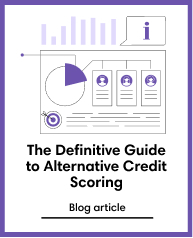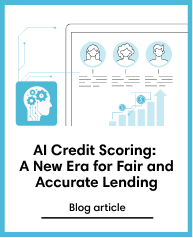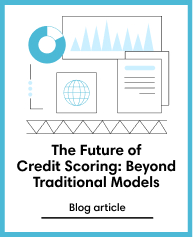Credit Scoring
Feb 3, 2022
Leveraging alternative credit scoring in the insurance industry
Subscribe to our newsletter
Insurance companies use credit information to determine whether a consumer is eligible to be covered by an insurance policy. Why would an insurer care about credit history? Because through credit information, it is possible to assess a consumer’s risk of insurance loss or the likelihood of a claim being made against an insurance policy.
Within the insurance industry, the term is referred to as a “credit-based insurance score”, and like any traditional credit scores, it is founded on credit report data such as payment history, amounts owed, length of credit history, credit mix and new credit. These credit categories influence the insurance credit score, and thus, the higher the score, the lower the predicted risk.
With the rise of alternative data and the ever-growing need to offer insurance policies to credit invisibles, many insurance providers are now looking into different methodologies for evaluating risk. Alternative data sources can help insurers better understand their clients and make better decisions concerning pricing, coverage terms, conditions, and, most importantly, their risk levels.
As well, the digital transformation within the insurance sector is enabling insurers to meet customer demands with greater efficiency. Thanks to artificial intelligence, machine learning, and predictive analytics, customers are having a better overall experience: services respond effectively, claims are processed instantly, and policy writing is done faster. Best of all, customers can now access policies online without the need to visit physical branches anymore.
Insurers are adopting these new technologies and alternative data sources to create a model of transparency between the client and companies and improve the number of policy subscriptions due to a more accurate risk evaluation.
Inclusive insurance: Helping the underserved
Broad access to an insurance policy is a key factor when evaluating a society’s chances of achieving social mobility. For a family with low income and no insurance, an adverse event can negatively affect the economic development of the entire household, and any chances of progress might be lost.
As expected, the gap between access to insurance in emerging and high-income markets is wide. In 2018, 3.8 billion customers in emerging markets were not served by traditional insurance providers. These credit invisibles make up a big potential profit for insurance companies. A study in 2015 by AXA identified the untapped global market for insurance among women, an important segment within the underserved, as being up to $1.7 trillion by 2030—of which a remarkable $874 billion in annual premium value would come from women in emerging markets.
Customers recognise the value of protecting against risk and are willing to purchase these products, but many insurance companies still rely just on traditional credit scoring. For example, FICO estimates that in America, approximately 95% of auto insurers and 85% of homeowners' insurers use credit-based insurance scores in states where it is a legally allowed underwriting or risk classification factor. This means that for all those consumers who do not have a strong credit history, there is little alternative to getting an insurance policy. If an applicant has no credit history, or if the history contains insufficient information to assess creditworthiness, insurance companies are much less likely to extend credit facilities or take over the individual portion of an insurance plan.
The lack of insurance is closely tied to patterns of economic and social inequality. The challenge of expanding financial inclusion involves thinking outside the box, beyond the traditional methods of evaluating a customer based on credit bureau data. This is where alternative credit scoring becomes extremely valuable.

Thinking outside of the box: Alternative data
Although this industry had been selling the same product since its inception centuries ago, many things are changing in the insurance sector worldwide. Online and mobile channels are reducing distribution costs, while data technology is transforming the very nature of risk—the core element of the industry’s business model. To this, we must add the change in mentality, habits and behaviours of customers and the new ways to capture and analyse valuable information. As a result, insurers are finding in the digital channel a means to streamline their tasks, be more efficient and, ultimately, more profitable.
In this way, it is possible to understand the level of risk and score consumers based on data sources such as everyday bills, like utilities, pay TV, and cell phone services, all of which are already part of people’s regular financial commitments.
At credolab, we use an alternative credit score based on smartphones and web metadata so that insurance companies can safely and accurately assess creditworthiness, converting metadata into credit insights. Insights can be gained from the most unlikely sources: for example, the number of contacts, how much storage is utilised, and the time of day that phone calls are made – these “features” can be entered into models to determine credit scores in a completely anonymous way.
Insurance companies can now calculate real-time credit scores based on evidence, shown in behavioural data from mobiles and web use. This previously untapped data means insurers can make decisions based on the way people behave in the modern world – not just how they look on paper.
Learn more about how credoSDK can help your business through a more predictive risk assessment.





